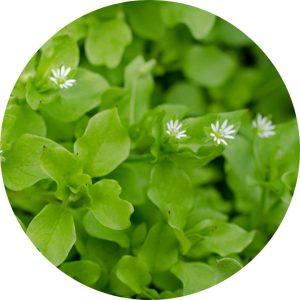Spring has sprung and soon so will the weeds. As the days get longer and the soil begins to warm, turf grass is coming out of winter dormancy and the race to establish a dense stand of turf begins. When scouting lawns and athletic fields for weeds, it’s important to ask yourself why a particular weed is there. The short answer is: underlying soil conditions. As you evaluate areas, different weeds tell different stories as to what’s going on with the soil. Given the wet, cool New England Spring we’re having, I expect to see more chickweed and clover this season. Read up on our Clover Blog from last week. Today, I’ll discuss the cause of chickweed how to control chickweed without pesticides on your turf.
 What is Chickweed?
What is Chickweed?
Chickweed is a winter annual that germinates early and is one of the first weeds to grow in the Spring. This plant has small white flowers and fleshy, egg-shaped leaves.
Where Does Chickweed Thrive?
This plant thrives in poorly structured soil. Therefore, consistently moist soil, compacted soil, and/or thin grass coverage becomes opportunistic for chickweed. Chickweed can dominate thin areas of lawn by forming dense mats, and does particularly well in shaded areas.
How to Control Chickweed Without Pesticides
No matter which weeds you find when scouting in the spring—you must create a dense stand of turf to crowd out weeds. This is accomplished through…
1.Proper Mowing
A high height of cut shades out prostrate growing weeds and limits weed seeds from getting to the soil surface. It is important to note that with a higher height of cut the turf grass will exhibit improved stress resistance, appearance and additions to organic matter. Following correct mowing protocol throughout the growing season is a critical cultural practice that can’t be overstated.
2.Seed-Slice
Once the sunny warm weather appears, common chickweed is going to die off and leave bare ground for the next weed to appear. Therefore, at this time of the season, it’s best to seed-slice those areas where there is chickweed as soon as possible. Due to chickweed’s poorly developed root system, the act of seed slicing should take care of the existing root system.
3.Aggressively Seed
Thin areas need to be overseeded to get turf grass into the area as quickly as possible. Like most forms of weed control in an organic lawn, improving turf density is critical in controlling common chickweed. Turf species diversity is also critical to enhancing competition on athletic fields and lawns. In the Spring, Rye Grass is going to be most prevalent. Early Summer – tall fescues and Kentucky blue will be most competitive. Over the heat of summer, Tall Fescue does a great job of remaining competitive with summer, then in late summer and fall, Kentucky blue and rye will dominate again. Maintain high species diversity and keep cultural practices as your highest priority to compete against weeds.
4.Perform a Soil Test
Soil testing gives you a baseline of where your soil is at and dictates product selection. When you soil test with PJC, we provide you a report with product recommendations in easy-to-understand format. Additionally, our Master Product Application Charts list by site product, # of bags, # of applications and when to apply for the season. We update it as new soil tests are taken—saving you time and making product decisions easy.
5.Contact PJC!
We make the whole process a lot simpler for you. We don’t only manufacture and distribute organic fertilizer and soil amendments. Here at PJC, we work with landscapers, schools, and municipalities to implement organic turf care programs successfully.
We’ve said it before and we’ll say it again (and again)…Address soil conditions and work in the Spring and Fall to establish a dense stand of turf that will crowd out weeds. It is possible to control chickweed all-naturally. Reach out for info on how we can help you implement organic turf care successfully!
